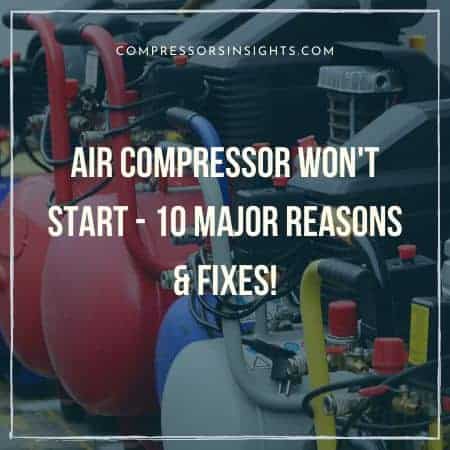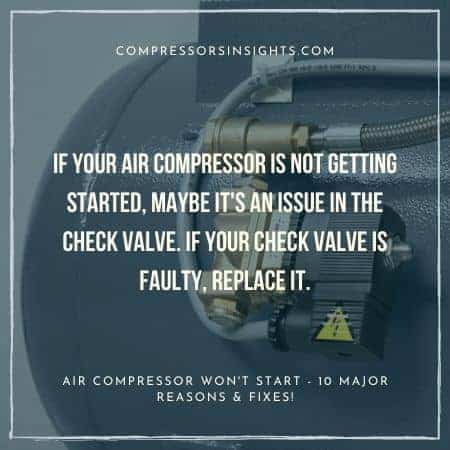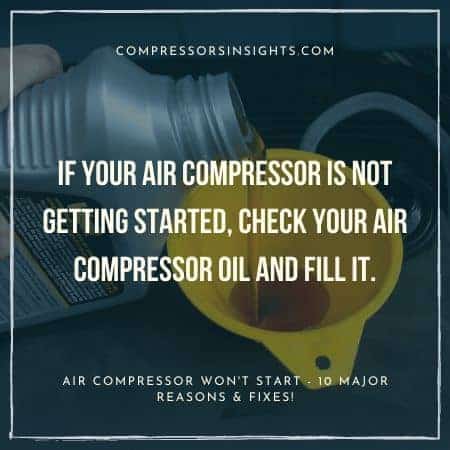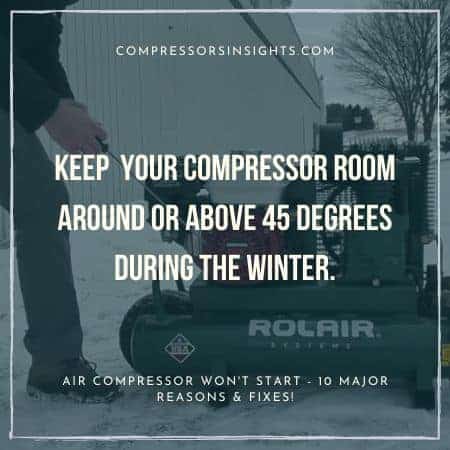Air Compressor Won’t Start – 10 Major Reasons & Fixes!
TheToolGeeks.com is a participant in the Amazon Services LLC Associates Program and other affiliate advertising programs. We may earn from qualifying purchases. (Learn More).
A compressor is an electric appliance with several different components that can malfunction at any time. It is expected that you’re working on a project, and suddenly your air compressor won’t start; that’s why we’re here to highlight some of the reasons for air compressor failure and how air compressor owners can prevent it.
There could be multiple reasons for air compressor failure, so we will see each reason and fix it. It’s time to fix your air compressor now!
In addition, we will also discuss why compressors hum. What does cold weather do to the compressor, and why are most extension cords not recommended?
Jump To Page Contents:

10 Reasons an Air Compressor That Won’t Start & How to Fix It?
The compressor is the machine that works best in any circumstance. It only needs maintenance and your care to last for a long time. If your compressor cannot start, there could be some reasons behind it.
1. Check for the Electrical outlet That is Supplying Power
If your compressor does not start, the most obvious thing to check is whether it has a power supply or power switch issue or not. Examine the wire connected to the outlets. There is the possibility that the fuse blew or the breaker tripped.
When there is a problem with the Power, a breaker may trip, or a fuse may blow. To fix the air compressor that won’t turn on because of the fuse, you need to replace the fuse.
If your electric outlet is bad, you need to switch the wire from the old outlet to the new outlet.
2. Check Valve Issue
A wear down because of the stress can cause the check valve to fail. When the compressor works more than it should, it causes wear and tears, affecting the valves.
When the compressor won’t start or starts to overheat, be sure to check its check valve. The overheating of the compressor leads to damage to the other parts, including check valves, and the damage in check valves can cause air leaks.
The check valve itself can cause trouble, and it can allow air to leak from the compressor while it is not working.
Steps to replace the check valve:
- Disconnect the Power
- Pull the ring to bleed out the air from the tank.
- Unscrew the pressure switch tube and remove it from the check valve.
- Unscrew and disconnect the outlet from the check valve.
- Unscrew and remove the check valve from the tank
- Now thread the new check valve in the tank.
- Reinstall everything you disconnected before.

3. Capacitor & Relays
Relays are devices that are used to protect compressor circuits. The Power goes through the relay into the compressor, and it adds winding in the circuit till the compressor starts.
When the capacitor malfunctions, the motor starts to overheat, vibrate, or won’t start. The motor does not work correctly when the capacitor is at fault. One of the first signs of capacitor failure is no cold air generated from the compressor. You may also hear some noise from the compressor if it doesn’t start or humming.
How to change the capacitor?
- Disconnect the Power.
- Removing the access panel.
- Note down the capacitance and voltage rating.
- Remove the old capacitor.
- Now install a new one.
- Connect it to the Power again.
4. Pressure Switch
Pressure switches are used to control the electric air compressor’s operations. When the compressor is below the needed pressure, the switch completes the circuit and gives power to the motor. There are several reasons behind the failure of the pressure switch including:
- Restricted air intake.
- Restricted combustion air vent.
Signs:
- When your air compressor is above the desired pressure, the pump still does not turn off.
- The pump is not turning on at cut-in pressure.
- Even though the pump is working, the pressure is low.
How to Replace the Air Compressor pressure switch?
- Switch off the electrical power and bleed off the air tank by pulling the ring on the safety valve.
- Remove the pressure gauge by unscrewing and removing it from the pressure switch.
- Remove pressure switch tube.
- Remove the pressure regulator assemble and remove it from the pressure switch.
- Disconnect all the wires.
- Remove the safety valve.
- Remove the pressure switch from the pipe connected to the tank.
- And now install a new pressure switch. Reinstall the safety valve by applying thread tape.
- Connect wires.
- Reinstall everything in its place.
5. Circuit Breaker Issue
The circuit breakers are issued when there is a fault in electricity, excess of a current, power surge, or defect in the component. The circuits trip because they are designed to trip to protect against electrical surges or other issues. Common reasons can be:
- Ground fault.
- Circuit load.
- Short circuit.
6. Check If there is Enough Oil In Your Air Compressor
Oil-lubricated air compressors come with a sight glass, and there is a dot in that. The oil level should be in the center of the mark. If the level is below the dot, load-bearing and coring happen. When there is not enough oil in the compressor, the compressor is not working correctly.
What to do if the oil level is low in the compressor?
You only need to pour oil into the intake port or on the low side of the compressor. While pouring oil, it rotates the hub and clutch, and it will slowly let the oil into the compressor.
Make sure not to fill your air compressor with the wrong compressor oil. Always ask a technician or read the user manual.
In Oil-free air compressors, you don’t need to check for any oil, as it’s not oil-lubricated.

7. Faulty Unloader Valve Problems
An unloader valve is part of the compressor used to release air from the tank, and it enables the motor to restart. When it does not work correctly, it causes: Pump motor stalling issue. When the gun in the system closes, the unloader valve needs to bypass the excess water and increase the cycle of the unloader.
Replace the Unloader Valve
If the unloader is defective, you only need to replace it. The typical unloader valve is simple. You can twist it and take it off. Turn it counterclockwise and pull it down, get a new one and put it in, and turn. It will go to the very end until it stops. Some unloader valves can have screws: which will be a side unloader. Either you can replace the screw ones, or you have to replace the whole switch.
8. Is there enough Air Pressure?
When the compressor does not have enough air pressure, it causes the air compressor to run for a long time and not reach its required pressure. As a result, it can end up shutting down the compressor.
How to increase the pressure in the compressor?
Use a screwdriver to remove screws over the pressure limiter. Then find two limiter switch screws. Turn on the compressor and adjust the screws until the low pressure reaches your desired level. You can leave the cover off. Usually, it takes 2.5 minutes for the compressor to get full force.
9. Air Compressor Motor Issue
Motors are usually the same in every air compressor, and they suffer from stress due to overwork, no lubrication, or dirt. Some other problems due to which the motor fails are the problem with the motor circuit or bad relay.
How to fix the electric motor of an air compressor?
Sometimes the contact points of the motor can get stained, so you need to open the part by unscrewing the two screws. And clean it using sandpaper. When contact points go back and forth, the transmission controls the spins of the motor.
10. Maybe Dirt or Moisture Stucked in Air Compressor Tank
The most common reason behind your air compressor failure can be a maintenance issue, or a cleaning issue. The dirt restricts the air intake and ends up having stress on the unit’s different components.
How to remove moisturizer from the compressor?
If the compressor contains water, open the drain valve and drain all the air, dirt, and moisture from it, followed by letting it open a few times to allow the compressor to dry out. The compressor has filters that prevent dust from going inside. Make sure the filters are checked to avoid this. Do air filter replacements if needed.
Now that you have cleaned the air compressor tank properly by draining it, it should be working as usual.
How to Maintain An Air Compressor for a Long time?
While maintaining the air compressor, you need to take care of these things:
- Do not try to fix the compressor without reading its manual
- Always recheck the nuts and bolts of the compressor. They could be loose.
- Clean the intake valves when needed
- Air Filter replacements when needed.
- Check the compressor’s hoses.
- Always clean the fuel tank of the compressor.
- Do not leave air in the tank.
- Ensure that the compressor’s safety shutoff system is working.
- Change the separator of oil and air.
- Change the Oil when needed.
Air Compressor Won’t Start If Tank is full
If your compressor cannot start under the load, you should check its check valve that must be stuck open. The check valve is the one that prevents the air from returning to the pump. If the check valve is stuck open, it causes high pump pressure, leading to the compressor not getting started.
Air Compressor Won’t Start Just Hums
Mostly at startup, the humming of the air compressor is common, but it can also happen while using. You can see a sudden pressure drop when your compressor hums. Possible the culprit behind the compressor hummin can be the motor, and it could be because of the load on the machine.
Possible reasons:
There are a few more possible reasons behind the humming of the compressor:
- Less Power.
- Problem with the unloader valve.
- Intake filters are clogged.
- Blocked tank valve.
- The capacitor is faulty.
Air Compressor Won’t Start On Cold
Winters can have adverse effects on the compressors. The compressor generates moisture, and in cold weather, it can freeze. The compressor should not be at a temperature that is less than 40-45F.
The winter can cause damage to the various components of the compressor, valves, control lines, and if you do not check it, the air that the compressor generates freezes. Winters can highly damage the performance of the air compressor.
The compressor can show glitches or even have trouble starting. The compressors need an average temperature to work, especially when placed outside. Temperature change, whether low or high, results in the compressor being unable to start.

Air Compressor Won’t Run On Extension Cord
The power cords of the compressor need to be plugged into the wall socket directly. Too-long or short extension cords can cause overheating, and overheating can burn the air compressor motor.
Extension cords can cause overheating, and it is mainly caused by overloading or because of an appliance that consumes more watts than it can handle. The extension cords also get damaged very easily. They should not be used permanently, only used temporarily.
Conclusion
An air compressor won’t start because of the possible reasons: Check for an Electrical outlet that is Supplying Power, Check If there is Enough Oil in Your Air Compressor, Maybe Dirt or Moisture Stuck in Air Compressor Tank, Capacitor & Relays, and some other which we have discussed in the article.
The compressors hum when the intake filters are clogged, the blocked tank valve the capacitor are faulty. Compressors create moisture, which can freeze during cold weather. A compressor should not be at a temperature below 40-45F.
FAQ’s
Is there a fuse for the air compressor?
There are two types of air compressors; one has a switch, and the other one has a fuse. Follow the power line from the compressor to the outlet if you want to find where the fuse is.
How to Reset an Air Compressor?
If you want to reset your air compressor, you need to give some time to let your compressor cool down. After it cools down, you can press the reset button present on the compressor and then attempt to turn on the compressor again.
Amazon and the Amazon logo are trademarks of Amazon.com, Inc, or its affiliates.
